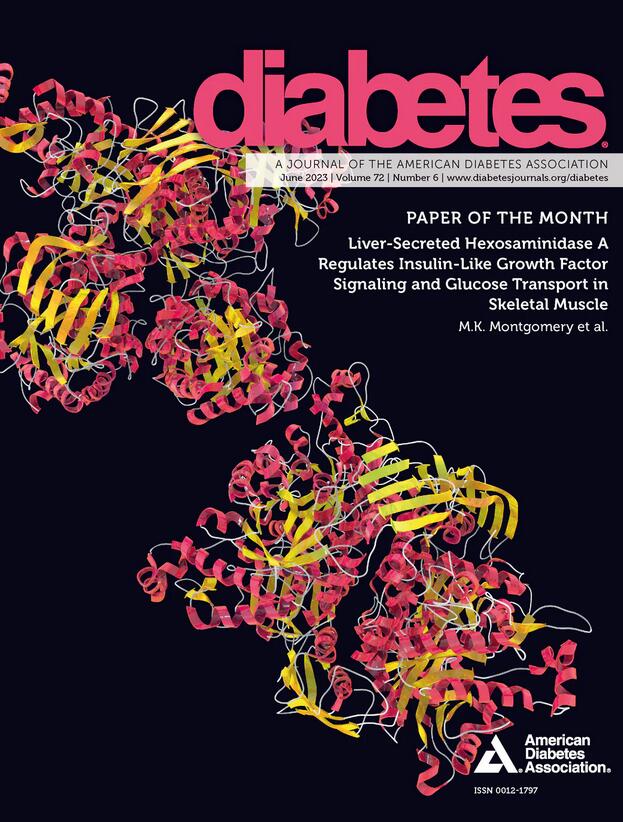1304-P: MODY计算器高估了具有青年发病2型糖尿病表型的多种族队列中的MODY概率
IF 6.2
1区 医学
Q1 ENDOCRINOLOGY & METABOLISM
引用次数: 0
摘要
引言& 目的:识别单基因糖尿病(MODY)仍然是临床医生面临的一项挑战。Shields 及其同事开发了一种广泛使用的基于临床测量的 MODY 概率计算器 (https://www.diabetesgenes.org/),以协助做出这一决定。由于该计算器主要是在成年欧洲白人人群中开发的,没有任何儿童 T2D 病例,因此我们试图在 ProDiGY(一个临床医生诊断为 20 岁以下 T2D 的多种族队列)中测试其准确性。方法:计算了 615 名临床医生诊断为 T2D 的青少年(SEARCH 中为 147 人,TODAY 中为 468 人;总体而言,非白人占 60%)的 MODY 计算器概率,其中包括 20 名患有 MODY 的参与者(3%)。考虑到这些研究的纵向设计,在多个时间点计算了每位参与者的 MODY 概率,从而得出了最大概率和中位概率。结果:在 20 名 MODY 患者中,19 人(95%)患有 MODY 的概率中值为 >60%。然而,该计算器高估了未检测到 MODY 变体的参与者的概率。事实上,85%未检测到 MODY 变异的人患 MODY 的最大概率为 >60%,67%的人患 MODY 的中位概率为 >60%。糖尿病家族史并不能区分糖尿病类型,更多的 T2D 患者的父母中有一人患病(64% 对 55%)。相比之下,HbA1c 和 BMI 都具有区分能力(ROC AUC >0.67)。结论在一组多种族青年糖尿病患者中,MODY计算器正确识别了MODY患者,但高估了临床表型为T2D患者的概率,这可能是由于诊断时年龄较小,且有阳性糖尿病家族史的比例较高。信息披露 R.J. Kreienkamp:无。B. Shields:无:B. Shields: None.T.I. Pollin:无:T.I. Pollin: None.M. Tosur:M. Tosur: None.A.S. Shah:无。A.D. Liese:无。C. Pihoker:无。S. Srinivasan:无。A.T. Hattersley: None.M. Udler:其他关系;最新。M.J. Redondo:无。RJK 由美国国立卫生研究院 T32DK007699 支持。SS 由美国国立卫生研究院 K23DK120932 和 R03DK138213 赞助。MJR 由美国国立卫生研究院 NIDDK R01DK124395 支持。本文章由计算机程序翻译,如有差异,请以英文原文为准。
1304-P: MODY Calculator Overestimates MODY Probability in Multiethnic Cohort with Youth-Onset Type 2 Diabetes Phenotype
Introduction & Objective: Identifying monogenic diabetes (MODY) remains a challenge for clinicians. Shields and colleagues developed a widely used MODY probability calculator (https://www.diabetesgenes.org/) based on clinical measures to assist in this decision. Because the calculator was developed in a predominantly adult White European population without any pediatric T2D cases, we sought to test its accuracy in ProDiGY, a multiethnic cohort with clinician-diagnosed T2D under age 20. Methods: MODY calculator probabilities were computed for 615 youth with clinician-diagnosed T2D (n=147 in SEARCH, n=468 in TODAY; overall, >60% non-White), including 20 participants with MODY (3%). Given the longitudinal design of these studies, MODY probability was calculated for each participant at multiple time points, allowing maximum and median probabilities. Results: Of the 20 individuals with MODY, 19 (95%) had a >60% median probability of having MODY. However, this calculator overestimated the probability in participants with no MODY variant detected. In fact, 85% of individuals without MODY had a maximum probability >60% of having MODY, and 67% had a median probability >60%. Family history of diabetes did not discriminate diabetes type with more T2D patients having a parent affected (64% v 55% in MODY). In contrast, HbA1c and BMI each had discriminatory capacity (ROC AUC >0.67). Conclusion: In a group of multi-ethnic youth with diabetes, the MODY calculator correctly identified those with MODY but overestimated the probability for those with a clinical phenotype of T2D, likely due to young age at diagnosis and high proportion with positive family history of diabetes. Disclosure R.J. Kreienkamp: None. B. Shields: None. T.I. Pollin: None. M. Tosur: None. A.S. Shah: None. A.D. Liese: None. C. Pihoker: None. S. Srinivasan: None. A.T. Hattersley: None. M. Udler: Other Relationship; Up-To-Date. M.J. Redondo: None. Funding RJK is supported by NIH T32DK007699. SS is supported by NIH K23DK120932 and R03DK138213. MJR is supported by NIH NIDDK R01DK124395.
求助全文
通过发布文献求助,成功后即可免费获取论文全文。
去求助
来源期刊

Diabetes
医学-内分泌学与代谢
CiteScore
12.50
自引率
2.60%
发文量
1968
审稿时长
1 months
期刊介绍:
Diabetes is a scientific journal that publishes original research exploring the physiological and pathophysiological aspects of diabetes mellitus. We encourage submissions of manuscripts pertaining to laboratory, animal, or human research, covering a wide range of topics. Our primary focus is on investigative reports investigating various aspects such as the development and progression of diabetes, along with its associated complications. We also welcome studies delving into normal and pathological pancreatic islet function and intermediary metabolism, as well as exploring the mechanisms of drug and hormone action from a pharmacological perspective. Additionally, we encourage submissions that delve into the biochemical and molecular aspects of both normal and abnormal biological processes.
However, it is important to note that we do not publish studies relating to diabetes education or the application of accepted therapeutic and diagnostic approaches to patients with diabetes mellitus. Our aim is to provide a platform for research that contributes to advancing our understanding of the underlying mechanisms and processes of diabetes.
 求助内容:
求助内容: 应助结果提醒方式:
应助结果提醒方式:


